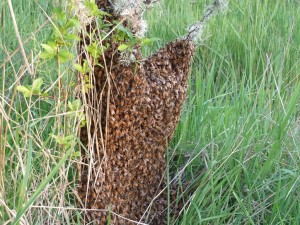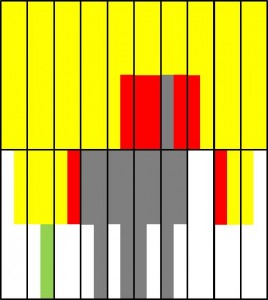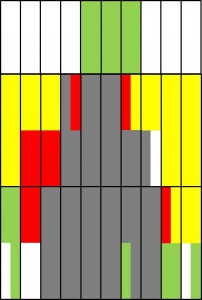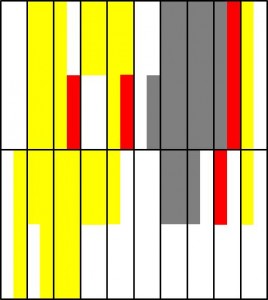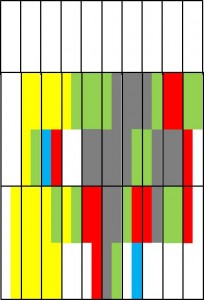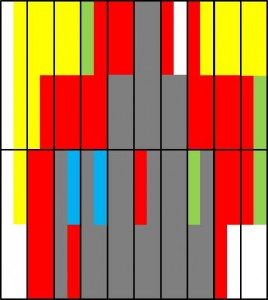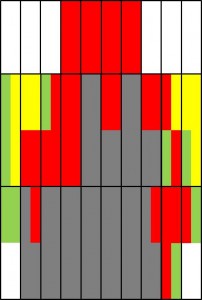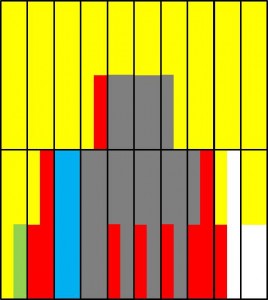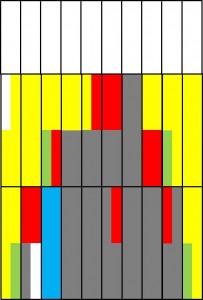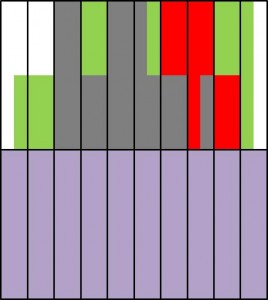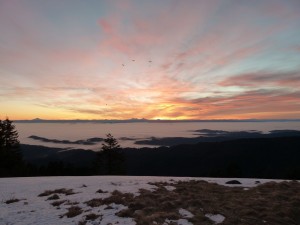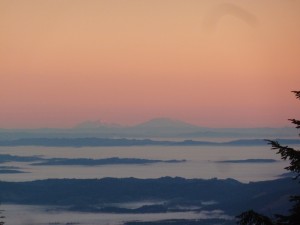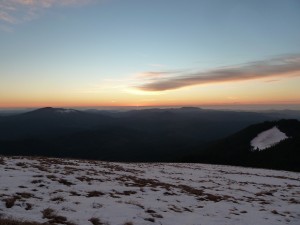This blog has attracted some new readers who think I write about bees. In fact, I write about whatever inspires passion and thought at the moment, and I’ll admit that I’ve been pretty passionate about bees for the past couple of months. After much splitting and re-queening, our colony count is at eight, and you can expect a new post here in two weeks or so when we do our next round of inspections.
For now, though, I turn my attention to the matter of religion, inspired by the always-thought-provoking writings of John Michael Greer, who last week addressed the topic of civil religion: schools of belief that have no spiritual basis but otherwise function similarly to traditional religions.
To begin with, what exactly is a religion? I offer the following definition: A religion is a system of values, ideas, and personal identity derived from a shared belief. This is contrast to what I will call a cultural identity, which I define as a system of values, ideas, and personal identity derived from shared history, traditions, and community. Both play similar roles in our lives, but religion can be distinguished by having a basis in belief while cultural identity has a basis in experience. In some cases they can overlap; for example Judaism is both a religion and a cultural identity for many people, while secular Jews reject the religion but retain their Jewish cultural identity, and recent converts to Judaism may adopt the religion but not the cultural identity.
Religions arise from the human need to have certainty in the face of an uncertain future. Because the future is always unknown, adherence a religion always requires some degree of faith. Some religions may have more empirical support than others, but the shared belief can never be declared true with 100% certainty, regardless of how many followers are convinced of its truth.
To get the rest of the definitions out of the way, religions may be conditional or absolute, and spiritual or civil. In conditional religions, the shared belief is held to be true only for followers of the religion, while in absolute religions the shared belief is held to be universally true (though special perks like salvation may be reserved for believers). Spiritual religions address the questions of “Is there a God?” and “What happens when we die?” while civil religions address questions such as “What should our society look like?”, “How can I plan for the future?”, and “How do we define success?”
Glossing over an enormous range of nuance, the spiritual religions range from the major monotheistic institutions to those grounded in atheism. The monotheistic religions contain both a set of core beliefs (in God and his major prophets) as well as a codified set of values and rules by which to live in order to be an adherent. Atheism is not really a religion, as the word describes only a shared belief (“There is no God,” or “There is no supernatural power beyond the reach of science.”). There are, however, religions that construct a set of values and morals based on atheism as a core belief; secular humanism is one such. Though most secular humanists would say they are not members of a religion, by my definition they are. It requires a degree of faith to believe that there is no God. To truly hold no spiritual religion, one must be agnostic.
Civil religions are perhaps more interesting, if only because they are seldom acknowledged as religions and their influence on society is greatly underestimated. They may arise out of cultural identities. Nationalism is usually the chosen term when cultural identities adopt beliefs (of superiority, manifest destiny, or the like) that enter the realm of religion. Political ideologies may become religions. Communism, during its heyday, was a conditional civil religion whose adherents believed that restructuring society in a particular way would create a utopian outcome. When no such utopias emerged in communist societies, the religious fervor faded. This illustrates the one major difference between civil and spiritual religions; because the belief at the core of civil religions lies within the physical realm, they are far less stable than spiritual religions over time. A religion cannot survive once its core belief has been proven false.
Drawing a bit from JM Greer, the dominant civil religion at the core of modern society is that of Progress. We believe that computers will be ever faster, that GDP and markets will always rise, that money invested now will be worth more when we retire, and that our children’s lives will be easier than our own. The central belief at the core of Progress is that technology and human ingenuity will allow expansion to continue indefinitely. Capitalism is upheld because competition inspires innovation. Social equality is suppressed for the same reason; inequality creates scarcity, which creates competition and therefore progress. Because we cannot be secure, we must have more than enough, always more.
Continued faith in the religion of Progress requires economic growth, rising standards of living, and breakthrough innovations. It is fairly obvious that these trends cannot continue indefinitely, and therefore that Progress will, like Communism before it, eventually crumble as a civil religion. That time may be drawing near, hastened by the fact that the modern society founded on Progress requires fossil fuels, and our fossil fuel reserves are rapidly dwindling. Malthus once predicted that Progress would be stopped by a shortage of food; it now seems more likely that the proximate cause will be a shortage of energy. Of course the prophets of Progress insist that technology will solve our energy problems and we will continue to grow powered by the Sun, wind, and nuclear reactors. Even if they are right, there is no shortage of scimitars waiting to strike a killing blow to the heart of Progress. Climate change and overpopulation are next in line, challenges we will face in the next 50-100 years. It remains true that infinite growth is impossible on a finite planet, and the larger we manage to grow before that reality catches up to us, the harder we are likely to fall.
John Michael Greer is the Grand Archdruid of the Ancient Order of Druids in America. He is also one of the leading prophets of a new civil religion, one that I will call Descent. The central belief of Descent is that alternative energies will be unable to fill the gap left as fossil fuels are depleted, and that declining energy availability will lead to scarcity, food shortages, and declining quality of life in the next 10-100 years. Descent places value on resilience and reduced complexity with the goal of meeting basic needs without relying on a fragile, vulnerable global supply chain. Its prophets suggest that not only will this approach improve quality of life as our energy descent proceeds, but that a life based on community self-sufficiency and strong local connections is ultimately more rewarding and joyful than a life guided by Progress.
Religions may reinforce, contradict, or simply coexist. Christianity and atheism are contradictory, as are Progress and Descent. It is possible to follow contradictory religions, though doing so creates intense cognitive dissonance and usually one will win out in the end. In earlier days, Christianity and Progress had an uneasy coexistence, but they have grown to reinforce, such that Biblical commands (i.e. “go forth and multiply”) are used to justify Progress.
While we typically don’t choose our cultural identity (though we can, if we desire), we are free to choose our spiritual and civil religions. Is there a way, then, to semi-objectively assess systems that are, by definition, based on subjective belief? Perhaps, and thus I present Mark’s objective assessment of religion. It is simply asking two questions. Regardless of whether the core belief is true or false,
- Does this religion allow me to live a maximally fulfilling life? and
- Would the world be a better place if all citizens followed this religion?
Of course the answers to those questions will be subjective, hence the “semi-objectively” wording above. But we can reduce subjectivity somewhat by defining a “better place” and a “fulfilling life.” To me, a fulfilling life is one in which I am able to do what my heart most desires and am not constrained by prejudice, discrimination, social class, financial hardship, or lack of basic needs. It is also a life in which I am surrounded by a community of mutually supportive people that enrich my life and that I can serve in turn with my skills. Similarly, the world is a “better place” if it provides the opportunity for a maximally fulfilling life to all of its citizens, free of nation-level inequality, corporate greed, vast differences in compensation, environmental injustice, etc. while also preserving the ecosystems and biodiversity that support us.
I will not attempt to judge the spiritual religions on this scale, except to say that all of the major religions are sufficiently diverse to include groups that focus on love, compassion, and inclusion and groups that focus on hatred, superiority, and exclusion. I will address the conflicting civil religions of Progress and Descent. While progress with a little “p” is value-neutral, the religion that has attached to it is far from it. There have been some dramatic gains, in eliminating common diseases and improving health care, in making travel faster and easier, in connecting the world (thus enhancing universal empathy) with the Internet. But equally there have been terrible losses, in biodiversity, in whole ecosystems, in pollution, in rising inequality, in the loss of local supportive communities in favor of consumerist individualism. As with the spiritual religions, different regions have used Progress to different ends, with more positive results (in terms of quality of life) in Scandinavia than in the US. But I would argue that Progress is not a conditional religion; that is, we don’t need to believe in progress for progress to happen.
Should we then believe in Descent? Descent is in many ways the antithesis of Progress, and its vision of the future may be closer to the truth. My problem with it is that it tends to be fear-based and pessimistic, thus failing test #1 by forcing sacrifice and preparation, decreasing one’s ability to lead a maximally fulfilling life. In other words, if the core belief of Descent proves wrong, its adherents will have spent a large amount of time worrying about and preparing for a situation that never came to fruition. If it proves right, they may be better prepared but will be no better off for having had fear in their hearts while waiting for the other shoe to drop. It may be wise to prepare for a world in which fossil fuels are scarce, but I do not think we should believe in this future, just as we should focus on meaningful progress without believing in it.
We need a new civil religion. With no enemy, we don’t have much nationalism, and nationalism is divisive anyway. Faith in major spiritual religions is declining, and they don’t substitute for civil religions. At this point most people in the developed world believe in Progress, and it appears that faith in Progress will soon be shattered. What then to believe in? Ourselves? (Narcissism as a civil religion?) Community? Connection to the Earth? What would it mean to believe in Community? Could we do it in a nested manner, caring foremost for our families and neighbors, but extending that to the state, nation, and world? Paganism is a spiritual religion with various historical baggage; could we craft an Earth-based civil religion, a global land ethic of sorts? I am open to ideas. Progress and Descent don’t do it for me.
You might be wondering what this Mark guy believes. My spiritual religion is a combination of a deep connection to the Earth and what might be called Conscious Creation, the latter being a belief that we are spiritual beings embodied on Earth to learn, create, develop in connection with others, and experience a material reality in all its natural and human forms. My civil religion is less clear. I believe in connection with community, though I have not yet found a community that I can connect with as I would like. I also have a strong land ethic, a desire to connect with the land I inhabit and make it fruitful while preserving natural functions and ecosystems. This derives from my spiritual connection but has non-spiritual dimensions as well – I view the land I inhabit as a reinforcing extension of my identity. I am still searching for a global civil religion, an alternative to Progress and Descent that emphasizes fulfillment in a steady-state, indefinitely-sustainable world of nested communities. If you find one, let me know…

